Flying is remarkably safe. But at the most dangerous airports in the world, you're more likely to experience a nail-biter takeoff or landing.
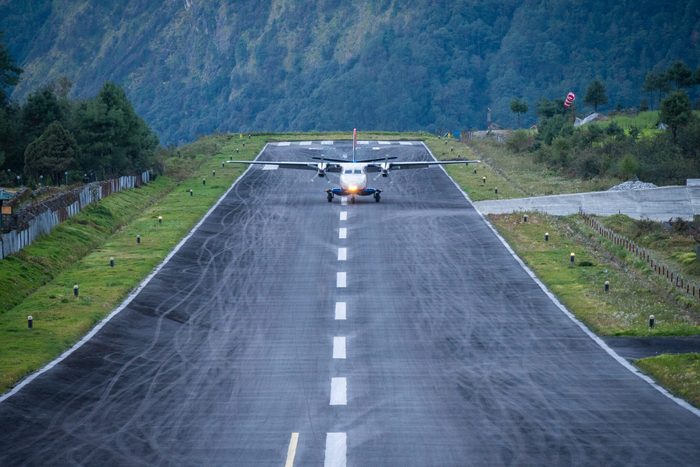
12 of the World’s Most Dangerous Airports

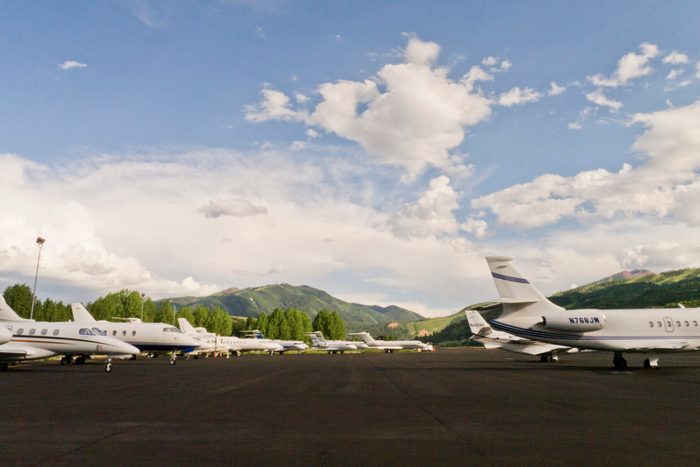
Aspen/Pitkin County Airport, Colorado
Aspen is a favorite of the jet set, but its high-altitude airport presents many challenges for pilots. Saddy—a Hawker 900XP captain and check airman who’s now a pilot liaison at Nevada-based Cirrus Aviation Services—has flown into the airport many times over his career. The location, he says, “combines high elevation, a short runway and surrounding mountains, all of which reduce options and demand precision.”
Complicating matters, Aspen’s weather can shift rapidly. “There are times when deciding whether to land feels like threading a needle,” he says. “You’re weighing performance, weather, surface conditions, company restrictions—any one of which might force a diversion.”
According to Saddy, Aspen’s Runway 15 can be especially nerve-wracking because it often exposes pilots to tailwinds that “extend the landing roll and push performance right to the edge of what’s allowable.” He recalls once facing conditions so tight that “every foot of runway mattered, and there was no room for a float or a gentle touchdown.” Other times, he adds, the safest choice was to divert to another airport altogether.
In 2022, gusty tailwinds here may have played a role in the crash of a Hawker 800XP private jet veering off the runway after the pilot aborted takeoff.
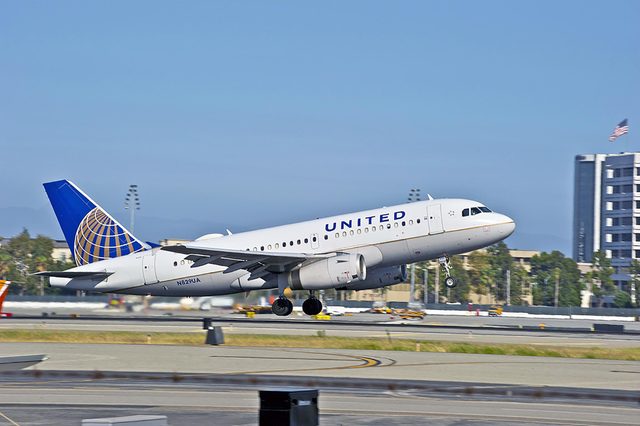
John Wayne Airport, Orange County, California
Take-offs at John Wayne Airport can feel abrupt, to say the least. Because the Orange County facility is surrounded by residential neighborhoods with stringent noise restrictions, planes must shoot up at a steep angle like rockets and then dramatically reduce power at low altitude. Saddy calls departures from here “one of the most unique” he’s had to navigate as a pilot. “From the cockpit, you need to manage this with precision. Timing is everything to ensure you meet both safety and noise requirements,” he says. For passengers, he notes, it’s quite a ride, and the abrupt juxtaposition between quick climb to sudden power reduction can put everyone on edge.

Madeira-Cristiano Ronaldo Airport, Portugal
Water approaches are one thing, but Madeira-Cristiano Ronaldo Airport, located on Madeira Island in the North Atlantic, takes it to another level. Its platform runway juts out over the ocean like a pier and is hemmed in by mountains. “The approach requires sharp turns and managing winds that often shift unexpectedly, particularly on short final [approach],” says Saddy of his experiences flying to the airport, where pilots are required to undergo special training to land. “The location between rising terrain and open water makes the winds tricky, with gusts and shear that can appear suddenly.”
When the conditions weren’t right, he’s had to make multiple attempts to land. Despite the airport’s demands and dangers, Saddy insists that discipline is key: “No shame in a go-around, and always be ready to try again.” Despite the stress, he adds, landing there is “incredibly satisfying when everything comes together.”
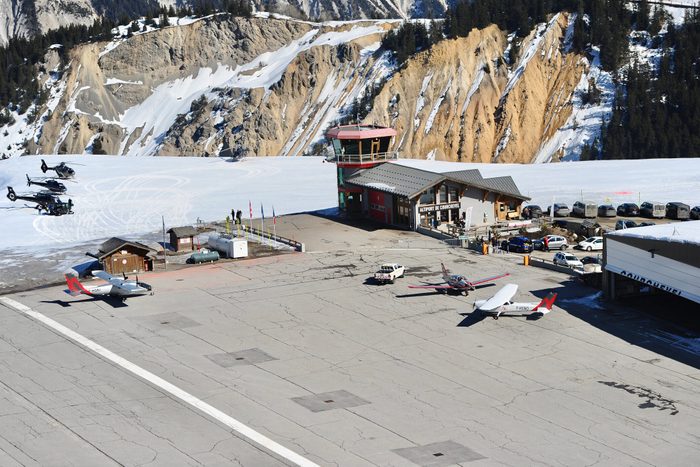
Courchevel Altiport, France
Set in the picture-perfect snowy French Alps, Courchevel Altiport is infamous for its short, upward-sloping runway that leaves no room for error. It’s so intense because once a pilot commits to land, there’s no option to abort and attempt a go-around if the approach isn’t perfect. After a Pilatus PC-12 was heavily damaged in a February 2024 crash at Courchevel Altiport, French investigators determined that the pilots’ lack of experience in mountainous terrain contributed to the aircraft’s nosegear striking the slope during landing.
For this reason, pilots have always been required to undergo special training to land at the famed ski destination—and even getting the opportunity to be certified can be difficult. “I went through the training for it but never got a chance to do it, unfortunately, as conditions weren’t in my favor,” says Saddy, who has flown into the destination as a passenger but never as a pilot. “It is quite the challenge to find the right time and conditions to do it.”
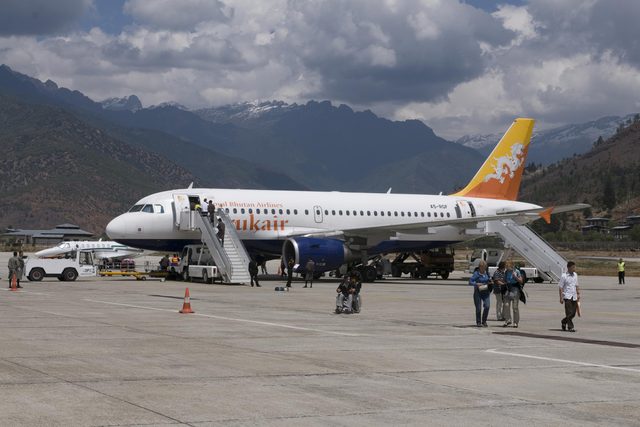
Paro International Airport, Bhutan
Paro International Airport in Bhutan is so high in the Himalayas that it offers arriving passengers stunning views, but its reputation among pilots certainly isn’t pretty. For starters, it has no radar guidance, so only visual flight rules are permitted, meaning all takeoffs and landings must be scheduled during daylight hours. Surrounded by towering peaks that reach as high as 18,000 feet, Paro sits at an altitude of just over 7,000 feet, and it’s considered so treacherous that reportedly only around 50 pilots are actually certified to land there.
If that weren’t bad enough, the thin air at the airport’s elevation reduces aircraft performance—a phenomenon known as density altitude—requiring pilots to fly with incredible control and accuracy as they execute multiple sharp banking maneuvers to avoid slamming into the mountains while lining up with the airport’s short runway.
Takeoff is also complex. “The airplane essentially ‘thinks’ it is performing at a higher elevation, which means it takes a longer distance on the runway for the airplane to develop sufficient lift to rotate off of the runway,” explains Dan Bubb, PhD, a former first officer at Air Vegas Airlines and the author of Landing in Las Vegas: Commercial Aviation and the Making of a Tourist City. “In this situation, it is even more important for pilots to accurately do a weight and balance calculation to determine whether the airplane will be able to rotate off of the runway”—especially for smaller aircraft that lack the powerful engines of a large turbojet.
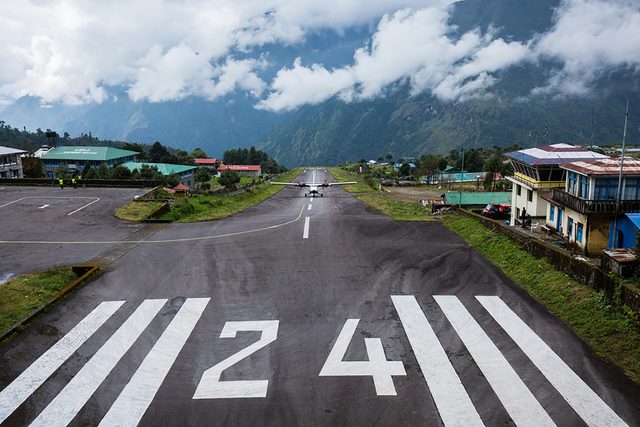
Tenzing-Hillary (Lukla) Airport, Nepal
Nepal’s Tenzing-Hillary Airport, the gateway to Mount Everest treks, welcomes adventurers who arrive each year to face off against the daunting peak. But before climbing enthusiasts take on the challenge, pilots must first contend with one of their own: landing using only visual flight rules on the airport’s notoriously steeply sloped, short runway in weather that can be wildly unpredictable at best. As in Bhutan, flying at high altitude adds complexity to the task.
But Lukla throws in another layer of difficulty, since the runway often seems to vanish, quite literally, into thin air (or at least fog and clouds). “Unusual runway surfaces can be challenging,” Bubb says. “If there is snow or ice, airplanes could potentially skid off of the runway.” Not exactly the smoothest start to the expedition of a lifetime.
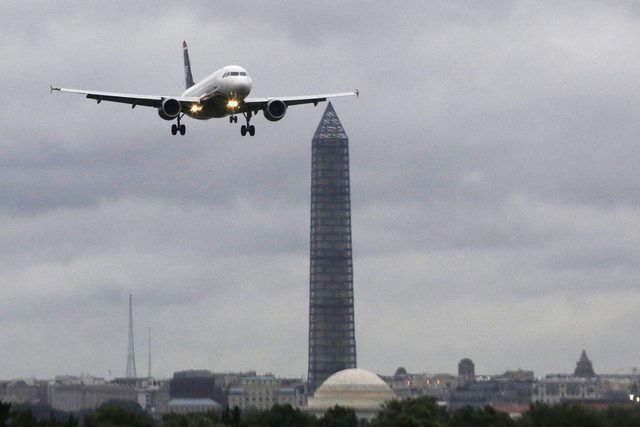
Ronald Reagan Washington National Airport, Washington, D.C.
On Jan. 29, 2025, a PSA Airlines Bombardier CRJ700 regional jet and a Sikorsky H-60 helicopter collided over the Potomac River, killing all 67 people aboard both aircraft. The airport’s visual river approach—used for one of its three runways—is notoriously tricky, choked with traffic due to everything from military operations to no-fly zones and flight restrictions in the nation’s capital. “Crowded airspace can be challenging because it is very busy airspace,” says Bubb. “This especially requires maximum attention and crew resource management because pilots likely will be given many instructions by air traffic controllers in addition to having to keep visual separation from other aircraft.”
In the wake of the crash, the FAA implemented modifications to helicopter flight corridors and introduced other safety measures, but Reagan National remains one of the U.S.’s most difficult airports for pilots to operate in and out of.
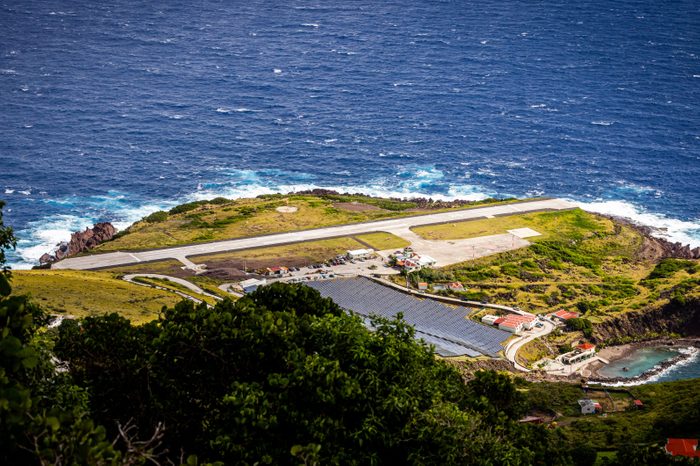
Juancho E. Yrausquin Airport, Saba, Dutch Caribbean
Juancho E. Yrausquin Airport holds the unique distinction of having the world’s shortest commercial runway—it’s a paltry 1,312 feet long. If that weren’t enough to set it apart, cliffs that border the runway on three sides plunge into the Caribbean Sea. Since any aircraft that overshoots its landing may face a deadly drop, only regional propeller aircraft are permitted to operate in and out of Saba. “Short fields like Saba,” says aviation expert Saddy, “demand precise speed, glidepath and touchdown point control.” The reason, he explains, is because there’s no room to “float” or ease into the landing. “You must get the aircraft down on the numbers, every time.”
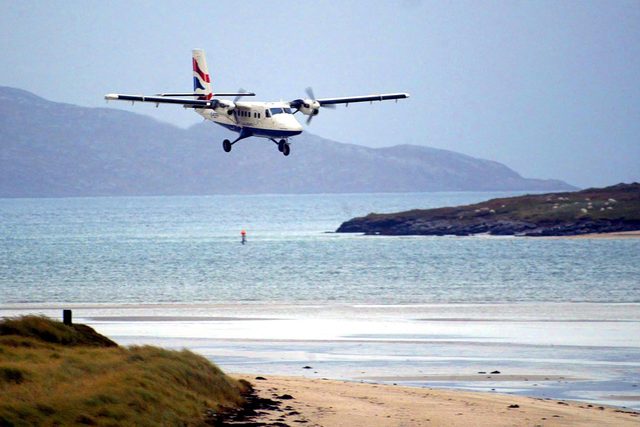
Barra Airport, Scotland
Sandy beaches are nice for lazing about on vacation, but if you find yourself on Barra, a remote island in Scotland’s Outer Hebrides, it’s best to double check you’re not actually on an active runway. This tiny island’s airport uses the beach as its main landing strip, which is only possible during low tide, when the shores aren’t totally submerged by the sea.
While it may sound cool, sand landings are usually anything but smooth. “Landing on a beach or unpaved surface means you need to adapt braking, steering and thrust settings to suit unpredictable conditions—it’s nothing like landing on a paved runway,” Saddy says. The beach is also completely unlit, so for safety reasons there are no night operations.
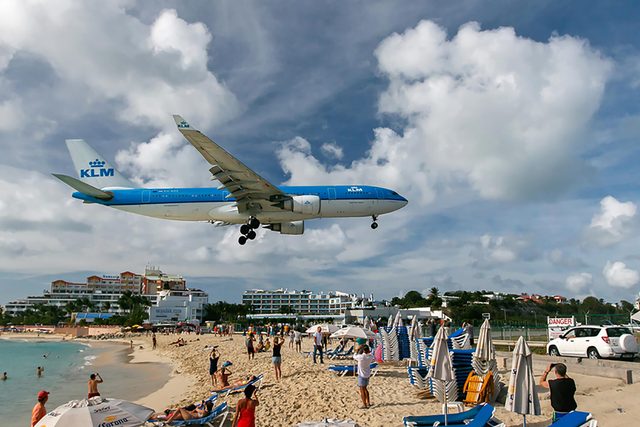
Princess Juliana International Airport, St. Maarten, Dutch Caribbean
You’ve likely seen the videos, even if you didn’t know the location—beachgoers and tourists bracing against powerful wind while gaping skyward as a jumbo jet screams overhead at startlingly low altitude. This is Maho Beach, right next to Princess Juliana International Airport in St. Maarten, where wide-body planes pass as little as a reported 30 feet above the sand and seemingly barely whisk past the airport’s fence during landing. The runway is short, creating an additional risk for disaster.
While pilots are well trained to handle the approach, it’s often those on the ground in greater danger. In 2017, a tourist from New Zealand died after she was knocked down by a departing Boeing 737’s jet blast. “Many tourists come to the island to experience the thrills of the landing of approaching aircraft flying low above their heads and the holding on to the airport fence and standing in the jet blast of large aircraft taking off,” police said at the time, BBC reported. “Doing this is, however, extremely dangerous.”
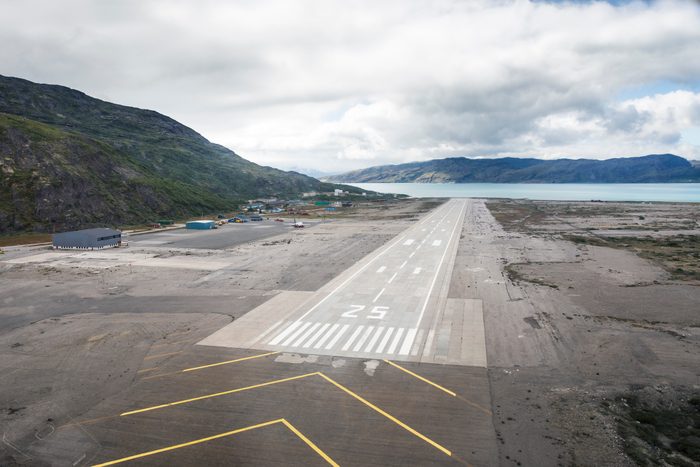
Narsarsuaq Airport, Greenland
Narsarsuaq Airport, in southern Greenland, is tucked deep within an icy fjord, so the rugged, mountainous setting is exposed to volatile Arctic conditions. “Severe weather conditions in any form can present significant challenges to pilots,” Bubb says. “This is why pilots must get a thorough weather briefing and make a critical decision whether to delay a flight, cancel it or land at an alternate airport.”
Saddy agrees, and he reminds nervous passengers that dicey landings at regional airports like Narsarsuaq are managed by the most rigorously trained professionals in the industry. “We go through specialized training, simulator practice and sometimes even airport-specific certifications to ensure we handle these conditions safely,” he says.
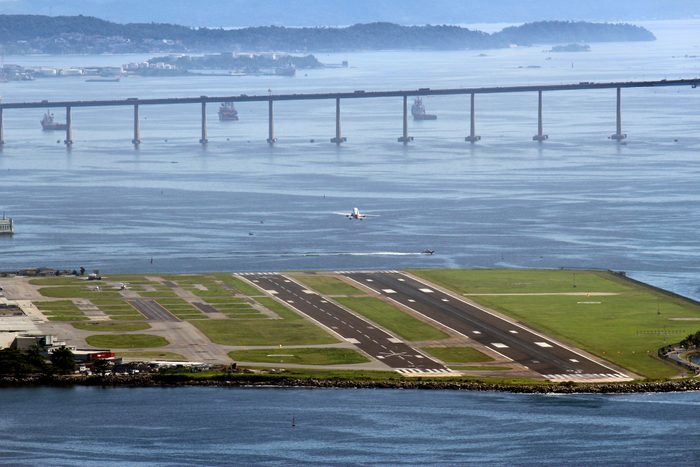
Santos Dumont Airport, Rio de Janeiro, Brazil
Santos Dumont Airport, in densely packed Rio de Janeiro, Brazil, is a bustling domestic hub, serving millions of passengers annually. Landing at this airport, built on landfill, tests pilots’ mettle because of its one-of-a-kind location in the city along Guanabara Bay, just beside the looming Sugarloaf Mountain. “Airports surrounded by terrain or dense urban areas leave no room for error,” Saddy explains. “At Santos Dumont, for example, pilots fly tight, curved approaches over a major city, requiring pinpoint altitude control and lateral precision.”
Compounding the challenge, the surrounding hills and water often produce wind shear and sudden crosswinds. As Saddy says, “Any deviation could have serious consequences.”
About the experts
|
Why trust us
At Reader’s Digest, we’re committed to producing high-quality content by writers with expertise and experience in their field in consultation with relevant, qualified experts. We rely on reputable primary sources, including government and professional organizations and academic institutions as well as our writers’ personal experiences where appropriate. We verify all facts and data, back them with credible sourcing and revisit them over time to ensure they remain accurate and up to date. Read more about our team, our contributors and our editorial policies.
Sources:
- Rock Saddy, pilot liaison, Cirrus Aviation Services; email interview, June 2025
- Dan Bubb, PhD, former first officer at Air Vegas Airlines, associate professor at the University of Nevada and author of Landing in Las Vegas: Commercial Aviation and the Making of a Tourist City; email interview, June 2025
- IATA: “Interactive Safety Report”
- Aspen Times: “Report: Plane That Went Off Aspen Runway ‘Would Not Become Airborne'”
- Aviation International News: “Ski Resort Accident Crew Had Little Mountain Experience”
- Simple Flying: “Why Bhutan’s Paro Airport Is Among the World’s Scariest”
- Federal Aviation Administration: “FAA Statements on Midair Collision at Reagan Washington National Airport”
- Airport Technology: “World’s Shortest Runways at Commercial Airports”
- BBC: “Sint Maarten Jet Engine Blast Kills New Zealand Woman”
- Rio and Learn: “Santos Dumont Airport: Handy Travel Guide”




















